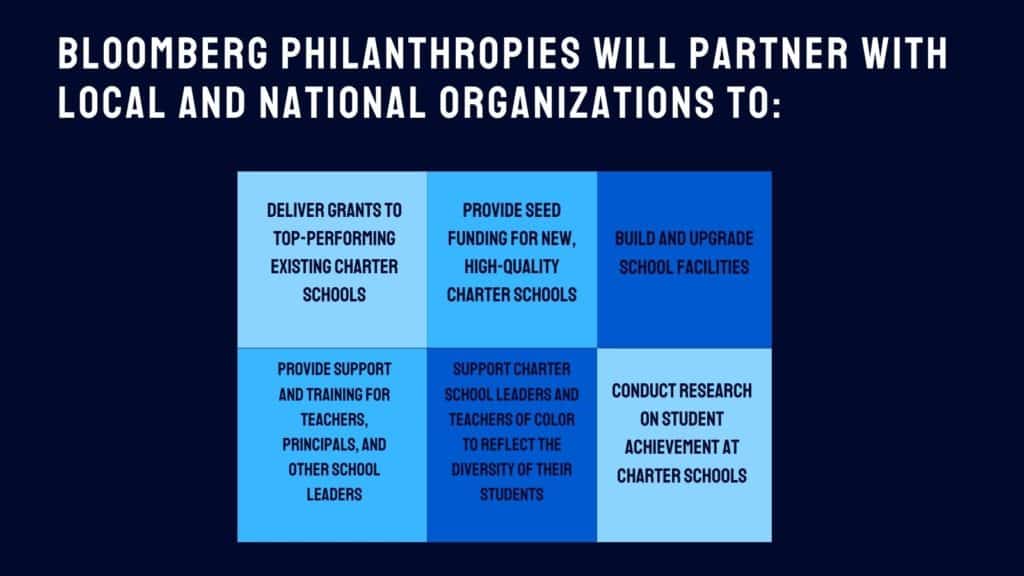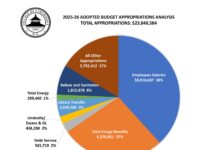
The past 18 months have shown that the American public education system is tragically broken, and we must act immediately to close the student achievement gaps which have existed for years but have been exacerbated by the COVID-19 pandemic, particularly for students from lower-income families.
On Dec. 1, Michael Bloomberg announced that Bloomberg Philanthropies is launching a national five-year $750 million effort to support the success and growth of existing charter and autonomous schools, open new high quality charter schools, and create city- and state-level conditions that will help sustain this progress. The plan will create 150,000 additional seats for children in charter schools in 20 U.S. metro areas, including New York City. It will help build a stronger, more equitable, and more modern model of public education – one that is based on evidence, centered on children, and governed by accountability and high standards.
“America’s public education system is broken. The pandemic hasn’t just underscored that reality – it has made it worse, and the remedy isn’t more tinkering around the edges,” said Michael R. Bloomberg, founder of Bloomberg LP and Bloomberg Philanthropies. “The future of our country depends on bold changes to education. While politicians fail to act with the urgency we need, this major new investment in public charter schools can help spread opportunity more equitably to students of all backgrounds nationwide.”
Bloomberg Philanthropies will be investing in public charter schools whose student populations have been deeply impacted by the pandemic and where, on average, more than 80 percent of students receive free and reduced price lunch, and more than 90 percent are children of color.
Data shows fewer public school students across the first through eighth grades were ready for grade level work in both math and reading when they returned to school in 2021 than before the pandemic. There is also evidence that the pandemic has been most detrimental for students in schools serving mostly Black and Latino students more than white students, and for students in schools located in lower-income rather than higher-income neighborhoods. For example, more than half of third graders in predominantly Black and Latino schools tested at least two grade levels behind in math and reading than pre-pandemic. And in areas where families earn less than $50,000 annually, third grade students were behind 12 percent in math and ten percent in reading (compared to six percent in math and four percent in reading for the children of families making more than $75,000). The National Center for Education Statistics reported in October 2021 that math scores for Black and Hispanic 13-year-olds have declined since 2012, while scores for white students and students of other races/ethnicities did not change.
A 2020 analysis shows that in tracking trends in student performance on the National Assessment of Educational Progress, student cohorts in the charter sector made greater gains from 2005 to 2017 than cohorts in the district sector. The difference in the gains amounts to nearly an additional half year of learning. Black students and students from lower income households attending charter schools made the greatest gains.
And while pandemic response has been immensely challenging for all schools around the country, studies show that charter schools leveraged their flexibility and autonomy to better meet the needs of students. A report from 2020 examined the practices of 356 small charter school networks and single-site schools—more than 65 percent of the national charter school community— during the initial pandemic-related school closures and found that they were more likely than school districts to set expectations that teachers would provide real-time instruction, check in regularly with students, and monitor attendance. Furthermore, eight leading charter school networks maintained structure for students by adhering to typical school days and prioritized student health and wellbeing through family outreach and support.
Eighty percent of the parents surveyed recently by the National Parents Union said the 2020-21 school year was an eye-opening experience and that they wanted to engage more with their children’s schools and provide more input and feedback. In 2020-2021 charter school enrollment increased nationally by 7.1 percent – nearly 240,000 students – amid the initial wave of the COVID-19 pandemic; one of the largest rates of increase in charter student enrollment in thirty years. At the same time, traditional public school enrollment dropped by 3.3 percent — a loss of nearly 1.5 million children.
It is clear that families want more, not fewer, public school choices and that they would select a charter or autonomous school if it were available to them. While some school jurisdictions have improved student outcomes by employing strategies and reforms focused on teacher and principal accountability, school level autonomy, student choice, and charter school growth, in too many places, leaders lack the political will and support to implement these necessary changes.
Bloomberg Philanthropies will partner with local and national organizations to:
- Deliver grants to top-performing existing charter schools – which will not include for-profit charters or fully virtual charters – so they can grow and scale to accommodate community demand
- Provide seed funding for incubating and opening new high quality charter schools with an emphasis on new models that appeal to students and families
- Build and upgrade school facilities
- Provide teacher, principal and other school leader training and support
- Support charter schoolteachers and leaders of color so charter school leadership can accurately reflect the diversity of their students
- Conduct and publish research on key drivers of student achievement across charter schools supported by this investment
Geographies selected offer a strong opportunity for serving the most in-need children coupled with conditions that could facilitate charter growth: strong operators to run good schools, regulators that ensure charters are high-quality, and a charter system that is – or is on track to be – of sufficient size to ensure durability.
As mayor of New York City (2002-2013), Michael R. Bloomberg made improving public education a top priority because he understood that a high-quality school is the best anti-poverty program yet invented. Under his leadership of the largest public school system in the nation:
- NYC’s public high school graduation rates increased 42 percent from 2005 – 2013
- The black-white achievement gap on graduation rates went from 23.9 points in 2005 to 18.3 points in 2012 – a 23 percent decrease. The Hispanic-white gap on graduation rates went from 26.6 points in 2005 to 20.6 points in 2012 — also a 23 percent decrease.
- NYC opened over 650 new schools – more than had been opened by any other administration in city history – including more than 150 charter schools, and added 126,000 classroom seats.
Bloomberg launched a charter sector in New York City that has continued to outperform district schools, validated by third party research. Charter school students in New York City showed significantly stronger growth in both reading and math in data from the 2011-2012 to 2015-2016 school years. Notable growth occurred among Hispanic and Black charter students in poverty, who posted stronger growth compared to their counterparts in traditional public schools.
Building on more than a decade of work in reforming K-12 NYC public education, Bloomberg Philanthropies has focused on supporting district and charter schools, identifying effective advocates, and improving leadership to help advance schools’ policy in jurisdictions around the nation. This new charter school initiative will make a significant difference for the children most in need of a great education and a route to a successful future.





